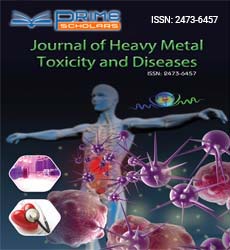Perspective - (2022) Volume 7, Issue 5
Contamination of Soil and Ground Water by Chromium Toxicity
Elise Laura*
Department of Chemistry, University of Munich, Germany
*Correspondence:
Elise Laura,
Department of Chemistry, University of Munich,
Germany,
Email:
Received: 31-Aug-2022, Manuscript No. IPJHMCT-22-14594;
Editor assigned: 02-Sep-2022, Pre QC No. IPJHMCT-22-14594 (PQ);
Reviewed: 16-Sep-2022, QC No. IPJHMCT-22-14594;
Revised: 21-Sep-2022, Manuscript No. IPJHMCT-22-14594 (R);
Published:
28-Sep-2022, DOI: 10.21767/2473-6457.22.7.5.16
Introduction
Chromium is one of the metal components that have been affirmed
to make three impacts (cancer-causing teratogenic and
mutagenic). Soil and groundwater contamination brought about
by chromium has been recorded as private information in China.
As of now, the ordinarily utilized strategies to eliminate Cr
(VI) from wastewater have the issues, for example, the impact
of debasement particles and the material can’t be reused. MCCS
has high expulsion productivity for Cr (VI), yet additionally has
great against impedance capacity for pollutant particles in real
wastewater. Still has great expulsion impact after 10 cycles. It is
an optimal C (VI) expulsion innovation in wastewater.
Description
Chromium Cr (VI), delegated perhaps of the most harmful poison
in wastewater, is regularly tracked down in surface water and
groundwater because of its far reaching use in enterprises, for
example, electroplating, printing and dyestuffs. As a rule, chromium
particles are essentially present in watery arrangements as
Cr (VI) and Cr (III), with Cr (VI) being more than 100 times more
harmful than Cr (III). The World Wellbeing Association (WHO)
specifies that the greatest reasonable grouping of Cr (VI) in drinking
water is 50 μg/L, and the US Ecological Security Agency (EPA)
has drawn a line of 1,00 μg/L for complete chromium in drinking
water. Subsequently, it is fundamental to create efficient, eco-accommodating
and powerful water treatment advances to eliminate
Cr (VI) from fluid arrangements. It is quite significant that
the decrease of Cr (VI) to Cr (III) or immobilization of Cr (VI) in the
emanating is a vital contamination the board technique. A scope
of adsorbents including enacted carbon, zerovalent iron metal
oxides and zeolites have been effectively applied. Enacted carbon
is broadly explored and utilized in huge amounts because of
its minimal expense, high explicit surface region and astounding
adsorption properties. Be that as it may, enacted carbon materials
stay the issue of being hard to recycle causing restriction in expansive application in water treatment. Attractive carbon nanomaterials
mitigate the above issue appropriately attributable to
its great adsorption and partition properties simultaneously. As
of late, numerous endeavors were made to set up the crude and
functionalized attractive carbon nanomaterial to eliminate the
poisons in the debased water climate. Effectively delivered the
attractive mesoporous Fe/C composite materials from squander
glycerol with amazing expulsion proficiency for Cr (VI) and partition
performance. Considering the recoverability and reusability
of attractive carbon, it is important to arrange the attractive
carbon or functionalized attractive carbon materials with stable
adsorption and recovery properties. Cellulose is additionally the
most seasoned and most plentiful normal polymer in the world,
making it an endless and the most important regular inexhaustible
asset for humankind. Involving cellulose as a wellspring of
carbon can assist with making productive utilization of biomass.
Changing this generally accessible substance into helpful items
makes great sense from a natural and monetary perspective. Chitosan
is the result of fractional acetylation of the normal polysaccharide
chitin, which has different capabilities like biodegradability,
biocompatibility, non-harmfulness and against bacterial.
Chitosan and cellulose both have comparative compound structures.
Specifically, chitosan, which contains free amino gatherings,
is the main fundamental polysaccharide among the normal
polysaccharides. The presence of an enormous number of amino
gatherings permits chitosan to respond synthetically with an extensive
variety of anions. The predominant reactivity of the amino
gatherings in the sub-atomic construction of chitosan permits
it to have incredible organic capabilities and to go through synthetic
adjustment reactions.
Conclusion
Hence, chitosan is viewed as a practical biomaterial with extraordinary
potential for application. In this, we have arranged
a chitosan-covered attractive carbon (MCCS) material utilizing
cellulose as the carbon source. Chitosan attractive carbon nano spheres have a uniform measurement (around 20 nm) and countless
hydroxyl and amino useful gatherings on a superficial level,
with a great attractive detachment execution. When applied
to chromium evacuation, the chitosan attractive carbon nanospheres
have a high adsorption limit (83.4 mg/g) and an exceptional
cycling recovery limit. After ten cycles, there was even over
70% expulsion of low convergences of Cr (10 mg/L). The adsorption
component study showed that both electrostatic cooperation
and decrease of chitosan changed attractive nanoparticles
were liable for the evacuation of Cr (VI).
Citation: Laura E (2022) Contamination of Soil and Ground Water by Chromium Toxicity. J Heavy Met Toxicity Dis. 7:16.
Copyright: © 2022 Laura E. This is an open-access article distributed under the terms of the Creative Commons Attribution License,
which permits unrestricted use, distribution, and reproduction in any medium, provided the original author and source
are credited.

